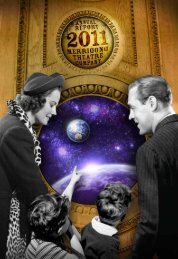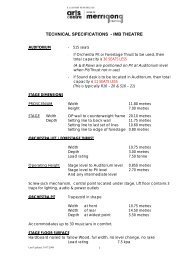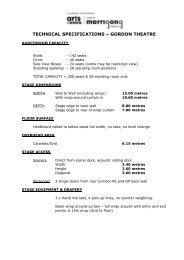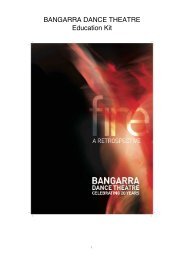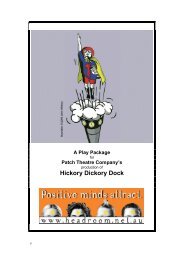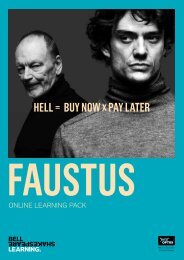UNTRAINED
UNTRAINED - Merrigong Theatre Company
UNTRAINED - Merrigong Theatre Company
- No tags were found...
You also want an ePaper? Increase the reach of your titles
YUMPU automatically turns print PDFs into web optimized ePapers that Google loves.
Reality Dance<br />
RealTime<br />
March 2009<br />
Reviewed by Keith Gallasch<br />
There are performance works that play with and disorient the senses—in Dance Massive,<br />
Simon Ellis and Shannon Bott's Inert, the Helen Herbertson-Ben Cobham Morphia series<br />
and Chunky Move's Mortal Engine; in recent theatre, Barrie Kosky's treatment of Poe's The<br />
Telltale Heart. At the same time, game and task-based works for performers and audiences<br />
are on the rise in live art events around the world, and in provocations such as Panther's<br />
exercises in happiness at the 2008 Melbourne International Arts Festival.<br />
These phenomena resonate, on the one hand, with the immersive media arts and virtual<br />
realities of the 21st century and, on the other, with computer game playing and the<br />
ongoing surge of popular competition, from quiz shows to reality TV. With none of the<br />
latter's dumbed down Darwinism, Lucy Guerin Inc's Untrained benignly offers us reality<br />
dance—an extended set of tasks that pit two trained dance artists (Byron Perry, Antony<br />
Hamilton) against two visual artists (Simon Obarzanek, Ross Coulter)—revealing much<br />
about how we perceive the human body and what we think we know about dance.<br />
The 'reality' of Untrained, however well constructed the overall work might be, is that the<br />
non-dancers' lack of dance skills provides a considerable likelihood of risk and of chance<br />
happenings, moments of surprising verve and sheer failure. Nor are the tasks simple for the<br />
trained dancers: there's a large quotient of improvisation and pas- sages where they have to<br />
closely mimic the unpredictable moves of the untrained or interpret their choreographies.<br />
As much as these amuse, they're also telling. The untrained pick up the broad patterns of<br />
movement, but rarely the detail (hinged on acute degrees of propulsion, balance and<br />
articulation), while the trained briskly realise additional layers of possibility.<br />
So, instead of a finished dance work, we are witness to a series of revealing portraits and<br />
tests with a chancy, cumulative impact. Above all, we are implicitly asked to look very<br />
closely at, and listen to, these four men, our role as observers considerably heightened.<br />
This is accentuated by the spare staging—a large open space with a square marked out in<br />
the middle, a frame in which everything hap- pens as soon as the men enter it from the<br />
queues they form either side. Initially, each man stands before us, motionless. We take<br />
each in. We'll subsequently see these same faces, these same bodies again, at rest (as if<br />
asleep), pulling faces, making weird sounds, reading aloud comments they've made about<br />
themselves. Towards the end, each of them simply stands before us again, but now we<br />
know more about them—not a lot (this is not the confessional faction of reality TV), but<br />
details of physiognomy and assessments of mobility, risk-taking, engagement with each



